Select Language
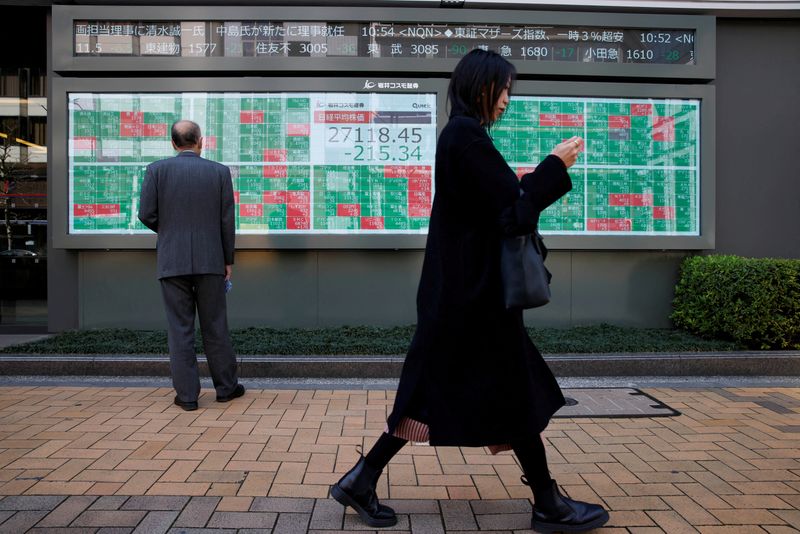
By Xie Yu
HONG KONG (Reuters) - Asian stocks slid to 11-month lows on Wednesday, U.S. futures dropped and the dollar surged as Treasury yields spiked back toward peaks on fears that U.S. interest rates will stay high.
A rebound in U.S. home sales was the latest trigger for concern in the bond market. Corporate earnings have also been mixed. Alphabet (NASDAQ:GOOGL) shares logged their worst session since March 2020 overnight, dropping 9.5% as investors were disappointed with stalling growth in its cloud division.
MSCI's broadest index of Asia-Pacific shares outside Japan fell 1%. Japan's Nikkei fell 2%. Alphabet shares slid another 2% after hours and pulled Nasdaq futures down by nearly 1%.
The benchmark 10-year Treasury yield, a bedrock for pricing risk-taking across financial markets, jumped 11 basis points (bps) overnight and traded at 4.96% on Thursday.
"There is no anchor in U.S. treasuries," said Ben Luk, Senior Multi Asset Strategist at State Street (NYSE:STT) Global Markets.
"If (the 10-year yield) doesn't stay below 5%, then I think it's still going to be a very choppy market for both U.S. and Asia," he said.
"Once you have more stable treasury environment, you will have a clearer earnings revision story," he added, noting markets dominated by tech firms, which rely heavily on financing, will be vulnerable to higher rates due to borrowing costs.
Shares in Facebook (NASDAQ:META) parent Meta fell 4% on Wednesday and another 3% in after-hours trade after publishing results showing better-than-expected revenue but a cloudy outlook, with expenses seen topping Wall Street estimates.
Australian shares fell to a one-year low, as stronger-than-expected third-quarter inflation data raised bets that the central bank might raise rates next month.
The S&P/ASX 200 index retreated 0.7% to 6,854.20 in early trade, hitting its lowest level since Oct. 31, 2022.
In the currency markets, the dollar index hit a two-week high of 106.77.
The yen weakened past 150 per dollar, a level that has put traders on guard for intervention to support the Japanese currency. By 0300 GMT the yen was trading at a one-year low of 150.43 per dollar.
The Australian dollar fell to an almost one-year low of $0.6271 in morning trade. The head of Australia's central bank on Thursday said the strong third-quarter inflation report was around policymakers' expectations, and they were still considering whether it would warrant a rate rise.
The New Zealand dollar also hit a nearly one-year low at $0.5776.
In China, markets' bounce on news that China would issue a trillion yuan ($137 billion) in sovereign debt was quickly fading away, with mainland and Hong Kong indexes winding back gains. The Hang Seng fell 0.8%.
Oil prices slipped. U.S. crude dipped 0.15% to $85.26 a barrel. Brent crude fell to $90.05 per barrel.
Oil prices rose about 2% on Wednesday on worries about the conflict in the Middle East, but gains were capped by higher U.S. crude inventories and gloomy economic prospects in Europe.
Gold was slightly higher. Spot gold was traded at $1983.015 per ounce.
South Korea's economy fared better than expected in the third quarter with the expansion underpinned by exports, backing the case for the central bank to keep rates on hold for the months ahead.
The won fell sharply, in line with the dollar's broad gains.
($1 = 7.3181 Chinese yuan renminbi)

By Lucia Mutikani
WASHINGTON (Reuters) - The U.S. economy likely grew in the third quarter at its fastest pace of any quarter in nearly two years, again defying dire warnings of a recession, as higher wages from a tight labor market helped to power consumer spending.
The Commerce Department's advance estimate of third-quarter gross domestic product on Thursday is also expected to show residential investment rebounding after nine straight quarters of declines. Business investment is believed to have slowed as the boost fades from the construction of factories. President Joe Biden's administration has taken steps to encourage more semiconductor manufacturing in the U.S.
While the anticipated robust growth pace notched last quarter is probably not sustainable, it would demonstrate the economy's resilience despite aggressive interest rate hikes from the Federal Reserve. Still, growth could slow in the fourth quarter because of the United Auto Workers strikes and the resumption student loan repayments by millions of Americans.
Most economists have revised their forecasts and now believe the Fed can engineer a "soft-landing" for the economy, citing expectations that the July-September period will show a continuation of second-quarter strength in worker productivity and moderation in unit labor costs.
"We're seeing the exact opposite (of a recession)," said Sal Guatieri, a senior economist at BMO Capital Markets in Toronto. "The American consumer, the biggest engine of the U.S. economy seems to have had a mid-year resurgence, largely because confidence improved through the summer because of the rally in the stock market and steadier gasoline prices."
According to a Reuters survey of economists, GDP likely increased at a 4.3% annualized rate last quarter, which would be the fastest since the fourth quarter of 2021. The economy grew at a 2.1% pace in the April-June quarter and is expanding at a pace well above what Fed officials regard as the non-inflationary growth rate of around 1.8%.
Estimates ranged from as low as a 2.5% rate to as high as a 6.0% pace, a wide margin reflecting that some of the input data, including September durable goods orders, goods trade deficit, wholesale and retail inventory numbers will be published at the same time as the GDP report.
Consumer spending, which accounts for more than two-thirds of U.S. economic activity, was likely the main driver, with Americans buying long-lasting goods like motor vehicles as well as going to concerts. Spending on goods appears to have picked up considerably because prices have come down.
A strong labor market has supported consumer spending. Though wage growth has slowed, it is rising a bit faster than inflation, lifting households' purchasing power. Growth in consumer spending is expected to have exceed a 4.0% rate after only rising at a 0.8% pace in the second quarter.
SPEED BUMP AHEAD
Student loan repayments resumed in October, which economists estimated was equal to roughly $70 billion, or around 0.3% of disposable personal income, and could dent spending. Though excess savings accumulated during the pandemic remain ample, they are largely concentrated among high-income households.
Low-income consumers are increasingly relying on debt to fund purchases, with higher borrowing costs boosting credit card delinquencies.
As a result, some economists see a sharp slowdown around the corner. Others are not too concerned, noting the labor market continues to churn out jobs at a solid clip.
"We see scary headlines about credit card debt rising too fast, but it had fallen quite a bit during the pandemic," said Luke Tilley, chief economist at Wilmington Trust in Philadelphia. "When you look at it as a share of people's monthly flow of income, it's actually fairly normal. I don't think that we've hit a point where it's a canary in the coal mine."
Labor market resilience should be evident in a separate report from the Labor Department on Thursday, which is expected to show a modest rise last week in the number of people filing new claims for unemployment benefits from the previous week's nine-month low.
The GDP data probably will not affect near-term monetary policy as financial conditions have already tightened with U.S. Treasury yields surging while the stock market sold off.
Financial markets expect the Fed to keep interest rates unchanged at its Oct. 31-Nov. 1 policy meeting, according to CME Group's (NASDAQ:CME) FedWatch. Since March, the U.S. central bank has raised its benchmark overnight interest rate by 525 basis points to the current 5.25% to 5.50% range since March 2022.
"I think that (strong GDP report) has already been incorporated into their thinking," said Yelena Shulyatyeva, a senior economist at BNP Paribas (OTC:BNPQY) in New York. "This has been our view that we have reached the terminal rate for this business cycle."
Growth last quarter was also seen lifted by a smaller trade deficit, thanks to strong exports and increased inventory investment. No impact was expected from the auto strikes, which started in mid-September. But the labor dispute, which is costing auto makers millions of dollars per week, could weigh on growth in the fourth quarter.
"I see a speed bump because of the strikes," said Brian Bethune, an Economics professor at Boston College. "But I don't see that suddenly we'll get thrown overboard."

By Milounee Purohit
BENGALURU (Reuters) - Indian consumer spending during this year's festival season will be slightly better than in 2022, said economists polled by Reuters, but probably not enough to ramp up the speed of what is already the world's fastest-growing major economy.
The broadly optimistic survey data, taken together with expectations for 6.3% growth this fiscal year and next, suggest even with a dip in inflation, prospects for a Reserve Bank of India interest rate cut are still a long way off.
Battered during the pandemic, consumption, which makes up for about 60% of Asia's third-largest economy has been slow to reach its pre-COVID levels.
While consumer spending in the current quarter was predicted to provide some lift to the economy, the overall growth outlook for the year has remained largely unchanged.
Nearly 75% of economists, 25 of 33, said spending during this year's festival season, which lasts from October through December, will be higher compared to last year. Among those, 21 said slightly higher and four said significantly higher.
The remaining eight said slightly lower.
GDP growth will average 6.3% this fiscal year and next, based on the median forecasts of a wider sample of 63 economists in the Oct. 16-25 survey. The median forecast was almost exactly the same in a September poll, 6.2% and 6.3%, respectively.
"Festive demand could be substantial this time, and I think that bodes well for private consumption expenditure in Q4, and I hope it delivers that extra kick it does every year," said Dhiraj Nim, an economist at ANZ Research.
"From a year-on-year growth rate perspective, it may not be a substantial upside so to speak."
Economists generally agree India needs an even higher growth rate to generate enough jobs for millions of young people who enter the workforce every year.
The RBI's bulletin early this year said India needs to grow 7.6% annually for the next 25 years to become a developed nation. No economist in the poll expects India to grow at that rate this year or next.
"India's long-term success will ultimately depend on whether it can create enough adequate jobs to leverage its huge demographic dividend. At the moment, employment is largely concentrated in the low-productivity agricultural sector," said Alexandra Hermann at Oxford Economics.
"In the current services-based model, achieving sustainable and inclusive growth will be challenging, though not inconceivable."
When asked what was India's potential economic growth rate over the next 2-3 years, economists returned a median range of 6.0%-7.0%.
The survey also showed inflation averaging 5.5% this year and 4.8% in 2024, higher than the mid-point of the RBI's 2-6% target range.
The RBI was expected to leave its repo rate unchanged at 6.50% until at least end-June of next year, with the first 25 basis point cut forecast to come in the July-September quarter, poll medians showed.
(For other stories from the Reuters global economic poll:)
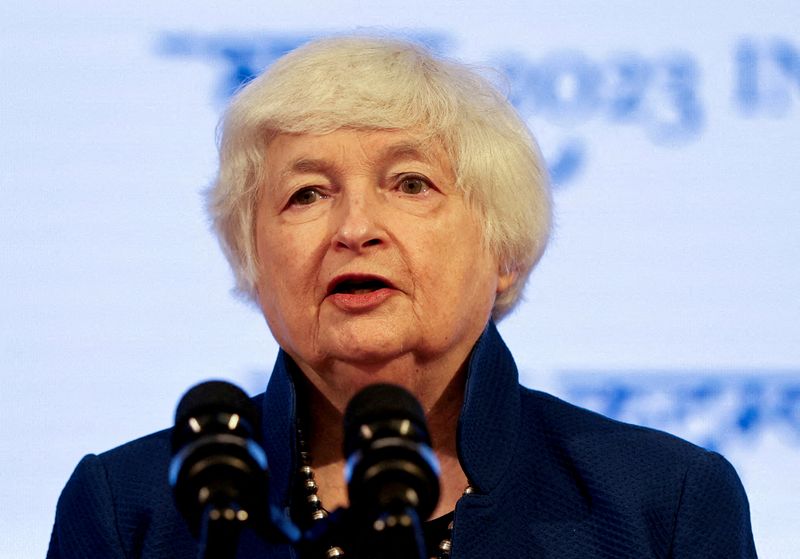
WASHINGTON (Reuters) - U.S. Treasury Secretary Janet Yellen said on Wednesday that $8.5 billion in COVID-era investments in community development financial institutions and minority-owned banking firms will boost lending to Black and Latino communities by nearly $140 billion over a decade.
Yellen said in prepared remarks to the Treasury's Freedman's Bank Forum that early reporting from the investment program indicates that one-third of total originations by recipient lenders were "deep impact" loans made to the hardest-to-serve borrowers.
"This is just the start," Yellen said of the Emergency Capital Investment Program (ECIP). "Over the next decade, we expect that ECIP will result in nearly $80 billion in increased lending in Black communities and nearly $58 billion in Latino communities."
The ECIP funding was authorized as part of a COVID-19 aid package approved by Congress in December 2020 and signed into law by then-President Donald Trump just before he left office. The program was implemented by the Biden administration.
Earlier on Wednesday, the Treasury announced a new goal to attract $3 billion in deposits to community development financial institutions and minority-owned banking institutions to help meet these lending targets, up from a $1 billion target for deposits reached in June.
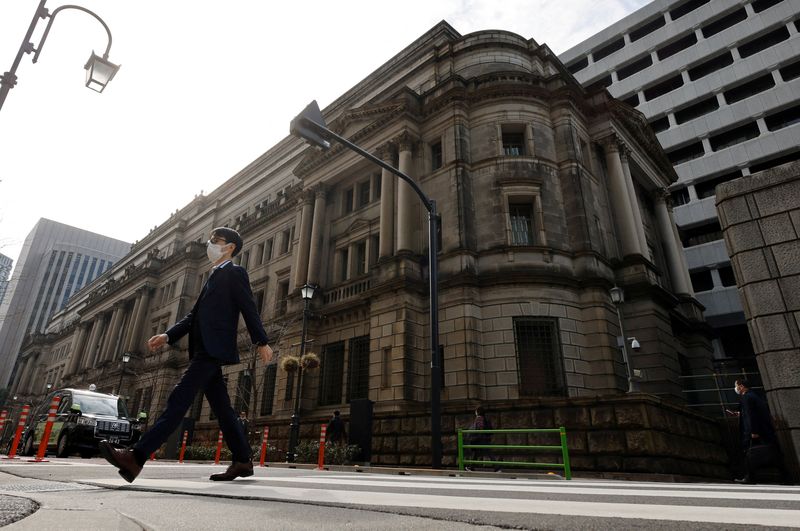
TOKYO (Reuters) - Japan's 10-year government bond yield touched a new decade-high on Wednesday on speculation that the Bank of Japan (BOJ) may raise its cap for the benchmark yield.
The 10-year JGB yield rose to 0.865% earlier in the session, its highest since July 2013. The yield retreated to 0.850%, up 1 basis point (bps) from the previous session.
A recent surge in global interest rates is heightening pressure on the BOJ to raise the existing cap on the 10-year bond yield at its policy meeting next week.
"If the BOJ raises the ceiling of the 10-year bond yield, that implies the BOJ's stance to protect its yield curve control (YCC) is different from before," said Naoya Hasegawa, senior bond strategist at Okasan Securities.
"When (Haruhiko) Kuroda was the governor, they conducted relentless bond buying to contain elevated yields. But according to what media has reported, the current administration is trying to raise the ceiling so that the BOJ can reduce the bond-buying amounts."
The BOJ has conducted several unscheduled bond-buying operations recently, including the one in the previous session. Strategists have said the BOJ has not aggressively tried to contain yields based on the amounts they offered to buy.
The central bank uses the YCC to guide the 10-year yield to around 0% to support the economy. In July, it raised the de-facto cap on the yield to 1.0% from 0.5% to allow long-term rates to rise more, reflecting increasing inflation.
The five-year yield was flat at 0.355%.
Yields on other tenors fell after a solid outcome of a liquidity-enhancing auction, with the 20-year JGB yield slipping 1.5 bps to 1.630%.
The 30-year JGB yield fell 2.5 bps to 1.830%.
The two-year JGB yield fell 0.5 bp to 0.070%.
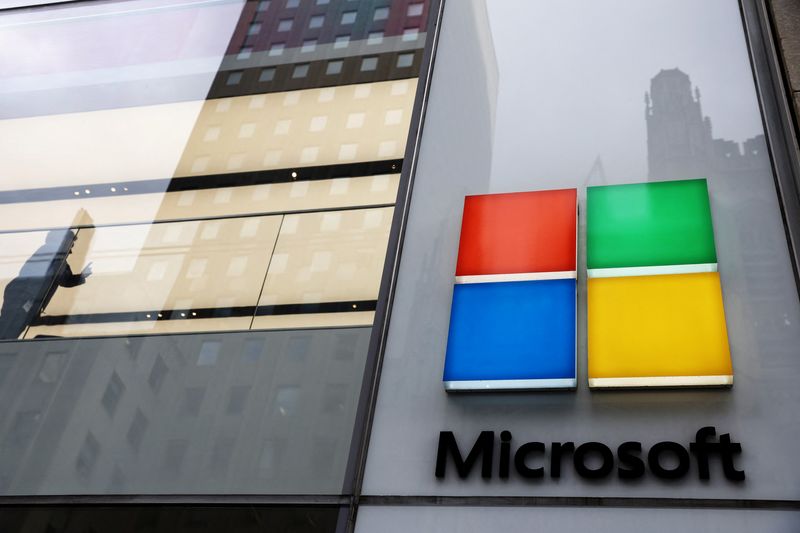
A look at the day ahead in European and global markets from Tom Westbrook:
Giants of tech and luxury goods have turned in mixed reports. Microsoft (NASDAQ:MSFT) and Google parent Alphabet (NASDAQ:GOOGL) each beat forecasts, but their share prices went in opposite directions as investors zeroed in on cloud computing.
Google shares fell 6% in after-hours trade. Microsoft shares rose 4%, leaving Nasdaq 100 futures down 0.3% in Asia.
Here's the wrapup of the pair's results.
Facebook (NASDAQ:META) parent Meta reports after-market on Wednesday. Its shares had fallen on Tuesday and slipped a little further after hours as dozens of U.S. states sued the company and its Instagram business, accusing them of addicting teens.
On the luxury front Kering (EPA:PRTP), owner of Gucci and Balenciaga, reported a bigger-than-expected drop in third-quarter sales. That was worse than the slowdown reported by LVMH, and the surprise jump in sales logged by Birkin-bag maker Hermes on Tuesday, which sent its shares up 3%.
Gucci's revamped look, unveiled last month in Milan by designer Sabato De Sarno, is yet to hit stores.
European loans data and a survey of German business conditions will be closely watched later on Wednesday. Santander (BME:SAN), Deutsche Bank and Dassault Systemes also report results.
In Asia, China's plans to raise a trillion yuan ($137 billion) in sovereign debt boosted Chinese shares in anticipation of spending and lifted MSCI's broad index of Asia ex-Japan stocks away from Tuesday's 11-month low. [MKTS/GLOB]
Central Huijin's vow to buy exchange-traded funds and keep doing so was also reminiscent of similar announcements from the state fund that drove strong rallies in 2013 and 2015. [.SS]
The Aussie dollar was the main mover in the foreign exchange market, rising as surprisingly strong inflation data prompted traders to re-price the risk of another rate hike.
Just this week, RBA Governor Michele Bullock said the bank would not hesitate to raise its 4.1% cash rate if there was a "material" upward revision to the inflation outlook.
Key developments that could influence markets on Wednesday:
Economics: Euro zone lending, German business survey
Earnings: Dassault Systemes, Deutsche Bank, CME Group (NASDAQ:CME), Hilton, Boeing (NYSE:BA) and, after market close, IBM (NYSE:IBM) and Meta
($1 = 7.3118 Chinese yuan)

By Kevin Yao
BEIJING (Reuters) -China is set to unleash fresh fiscal stimulus to shore up its economic recovery, drawing on a well-used playbook that relies heavily on debt and state spending but falls short on the deeper reforms called for by a growing number of analysts.
Some government advisers are recommending China lifts its 2024 budget deficit target beyond the 3% of gross domestic product (GDP) set for this year, which would allow Beijing to issue more bonds to revive the economy, policy insiders and economists have told Reuters.
The world's second-largest economy grew faster than expected in the third quarter, improving the chances Beijing can meet its growth target of around 5% for 2023.
But while the upbeat surprise gave battered China investors some cause for cheer, there are deeper concerns about the continued demise of private sector activity and the lack of longer-term reforms needed to shift the economy to consumer-led growth.
For now, the focus remains on sustaining a fragile recovery to avoid economic disaster.
"We need to make good preparations for next year and implement policies to stabilise growth. The foundation of economic recovery is not solid," said an adviser to the cabinet who spoke on condition of anonymity.
"For next year, we should still set a 5% GDP growth target."
China's parliament is set to approve just over 1 trillion yuan ($137 billion) in additional sovereign debt issuance when it concludes a five-day meeting that began on Oct. 20, sources told Reuters.
Such bonds will likely be used to fund water conservancy and flood prevention projects and come on top of an expected front-loading of 2024 local bond quotas.
CALLS FOR AMBITION
China's feeble post-pandemic recovery has exposed growing structural constraints and raised a sense of urgency around reforms to put growth on a more sustainable footing.
The debate about economic policy in China has heated up in recent months with some government advisers advocating reforms to help unleash new growth engines beyond property and infrastructure investment.
For those looking for structural reforms, the focus is on policies that spur urbanisation and household spending power, reduce the reliance on investment and level the playing field between state-owned enterprises and private firms.
Without such changes, economists warn China could be headed for a long-period of deflation and stagnant growth that fails to lift living standards for the country's 1.4 billion people.
However, near-term needs have largely overshadowed those calls for more politically ambitious reforms and instead centre on authorities stepping up fiscal and monetary support.
Local governments have been told to complete the issuance of the 2023 quota of 3.8 trillion yuan in special local bonds by September to fund infrastructure.
Some advisers say the central government has room to spend more as its debt as a share of GDP is just 21%, far lower than 76% for local governments.
"Fiscal policy should still play the leading role next year," said Xu Hongcai, deputy director of the economic policy commission at the state-backed China Association of Policy Science.
"For next year, actual growth could be lower than 5% but it cannot be too low, otherwise some problems will become more striking, such as employment and incomes," Xu told Reuters.
The central bank, which delivered modest interest rate cuts and has pumped more cash into the economy in recent weeks, is constrained in how much it can ease monetary policy for fears of stoking capital flight and hurting the yuan, analysts said.
"There is still room to cut interest rates and reserve requirement ratios but there is a question of sustainability," said Guan Tao, global chief economist at BOC International and a former official at the State Administration of Foreign Exchange (SAFE).
However, policy insiders believe more fundamental changes, especially a revival of market-based reforms, will be limited due to the political environment, under which the state has increased its control over the economy, including the private sector.
An expected Communist party plenum, which is likely to take place in November and traditionally focuses on reforms, could disappoint those awaiting big changes.
"We should push reforms as many problems are structural, but reforms are difficult to implement and require political will," said one policy insider.
($1 = 7.2987 Chinese yuan)

By Stella Qiu
SYDNEY (Reuters) -Australian inflation was surprisingly strong in the third quarter amid broad-based and stubborn cost pressures, a headache for policymakers that added greatly to the risk of a rise in interest rates as early as next month.
Investors reacted by narrowing the odds on the Reserve Bank of Australia (RBA) restarting the tightening cycle next month after four months of pauses, with futures now pricing in a 66% chance of a quarter-point hike to 4.35%, compared with 35% before the data.
Data from the Australian Bureau of Statistics on Wednesday showed the consumer price index (CPI) rose 1.2% in the third quarter, above market forecasts of 1.1% and up from a 0.8% increase the previous quarter.
The annual pace of inflation slowed to 5.4%, from 6.0%, but was again above forecasts of 5.3%. For September alone, the CPI rose 5.6% compared to the same month a year earlier, up from 5.2% in August.
A closely watched measure of core inflation, the trimmed mean, rose 1.2% in the third quarter, to top forecasts of 1.1%. The annual pace slowed to 5.2%, from 5.9%.
The Australian dollar rose 0.6% to a week high of $0.6398 and three-year bond futures tumbled 15 ticks to 95.68, the lowest since 2011. Markets are now seeing rates peaking at 4.45% early next year, up from 4.35% before the data release.
Adam Boyton, head of Australian research at ANZ, now sees a quarter-point hike from the RBA next month, given the uncomfortably high inflation and the recent hawkish guidance from policymakers.
"While 4.35% should mark the peak in the cash rate, there is a risk it could tighten beyond that. Any easing remains a very long way off," Boyton said.
The biggest contributors to the third quarter inflation were fuel, rents, and electricity. Fuel prices rose 7.2% from a year ago, reversing two quarters of price falls, with the conflict in the Middle East potentially set to further stoke inflationary pressures.
Inflation remained elevated for a range of services such as vets, restaurant meals and hairdressers. Rents rose 7.6% from a year ago, the fastest since 2009.
One silver lining in the report is that food prices registered the slowest quarterly rise in two years as prices fell for fruit and vegetables.
Supermarket giant Woolworths said on Wednesday that average prices for the products it sold in the September quarter rose just 2% over a year earlier, a significant moderation compared with previous quarters.
Still, Michele Bullock, the new RBA governor, on Tuesday warned that there were risks inflation would prove more stubborn than expected and interest rates might have to rise further to bring it to heel.
Policymakers have said they have a low tolerance for allowing inflation to return to target at a slower pace than currently expected. The central bank forecast in August that inflation was only projected to return to the top of the bank's target band of 2-3% in late 2025.
The central bank will release its updated economic forecasts in early November.
"This brisk pace of core inflation signals that cost pressures are broad and heightened in the economy, in part stemming from the very tight labour market," said Sean Langcake, head of macroeconomic forecasting for Oxford Economics Australia.
"Governor Bullock's communications this week have laid the ground work for tighter policy, and the tick up in core inflation could well justify another round of rate hikes."
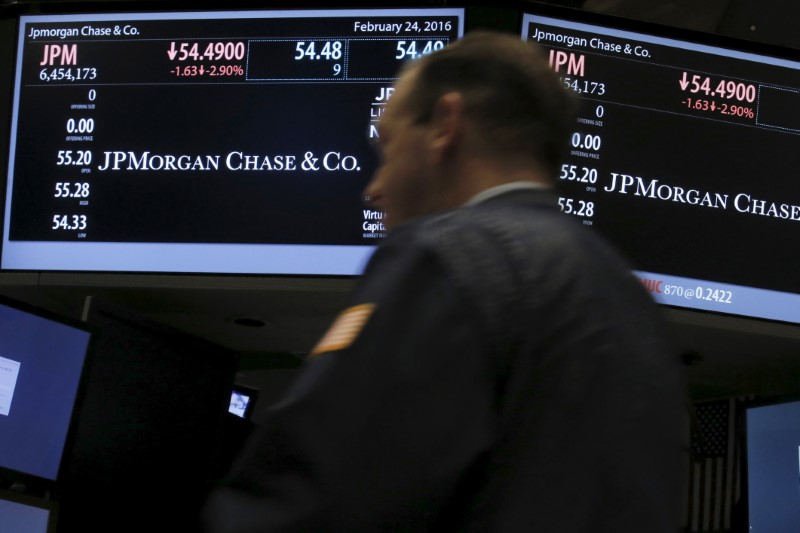
Jamie Dimon, CEO of JPMorgan, has expressed skepticism about the effectiveness of central banks' economic forecasts in navigating potential economic turbulence. Speaking at the Future Investment Initiative Summit, Dimon urged preparedness for diverse economic outcomes and criticized the excessive reliance on governments and central banks to steer through economic challenges.
Dimon also downplayed the potential effect of an additional 25 basis point hike by the Federal Reserve. This comes after a series of 11 rate hikes since 2022, with no further adjustments expected in November. Despite these increases, Dimon's comments suggest that further hikes may have a limited impact on the economy.
In his address, Dimon also voiced concerns over record peacetime fiscal spending and global overspending. He highlighted these aspects as potential destabilizers to economic stability. Furthermore, he pointed out the ongoing conflict in Ukraine as another factor that could potentially disrupt economic stability globally.
The CEO's remarks underscore a growing sentiment among financial leaders regarding the limits of monetary policy in addressing complex global economic issues. His call for readiness rather than definitive predictions indicates a shift towards a more cautious approach to economic planning and forecasting amidst an increasingly uncertain global economic landscape.
This article was generated with the support of AI and reviewed by an editor. For more information see our T&C.

By Kanishka Singh
WASHINGTON (Reuters) -Officials from the United States and China on Monday held a two-hour long virtual meeting to discuss domestic and global macroeconomic developments, the U.S. Treasury Department said, calling the meeting "productive and substantive".
THE TAKE
Ties between the world's two largest economies have been strained in recent years due to a number of issues including Taiwan, the origins of the COVID-19 pandemic, allegations of spying, human rights issues and trade tariffs.
Senior officials from both sides have been meeting each other in recent months to lay the ground for an expected meeting between U.S. President Joe Biden and Chinese leader Xi Jinping in San Francisco in November.
KEY QUOTES
"Today, the United States and the People's Republic of China held the first meeting of the Economic Working Group (EWG), which serves as an ongoing channel to discuss and facilitate progress on bilateral economic policy matters," the Treasury Department said.
China's finance ministry said the two sides had "in-depth, frank and constructive" talks, and also discussed bilateral cooperation in "addressing global challenges".
Both sides will continue to maintain communication, the ministry said.
U.S. and Chinese officials also raised "areas of concern," statements from the two sides said, without elaborating. The meeting was led by senior officials from the U.S. Treasury Department and China's finance ministry.
The EWG was launched last month following U.S. Treasury Secretary Janet Yellen's trip to Beijing in July. It was launched in parallel with a financial working group, which will hold its first meeting on Wednesday.
CONTEXT
The economic meeting follows other high-level engagements between the two countries in recent months that have seen visits from U.S. officials to China like Secretary of State Antony Blinken in June, Yellen in July and Commerce Secretary Gina Raimondo in August.
More recently, Blinken met Chinese Vice President Han Zheng in New York and U.S. National Security Adviser Jake Sullivan met Chinese Foreign Minister Wang Yi in Malta. China's top diplomat will travel to the United States later this week to meet Blinken.

